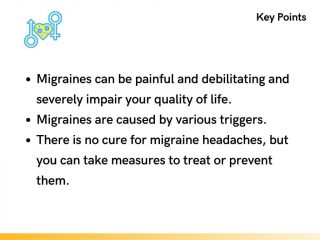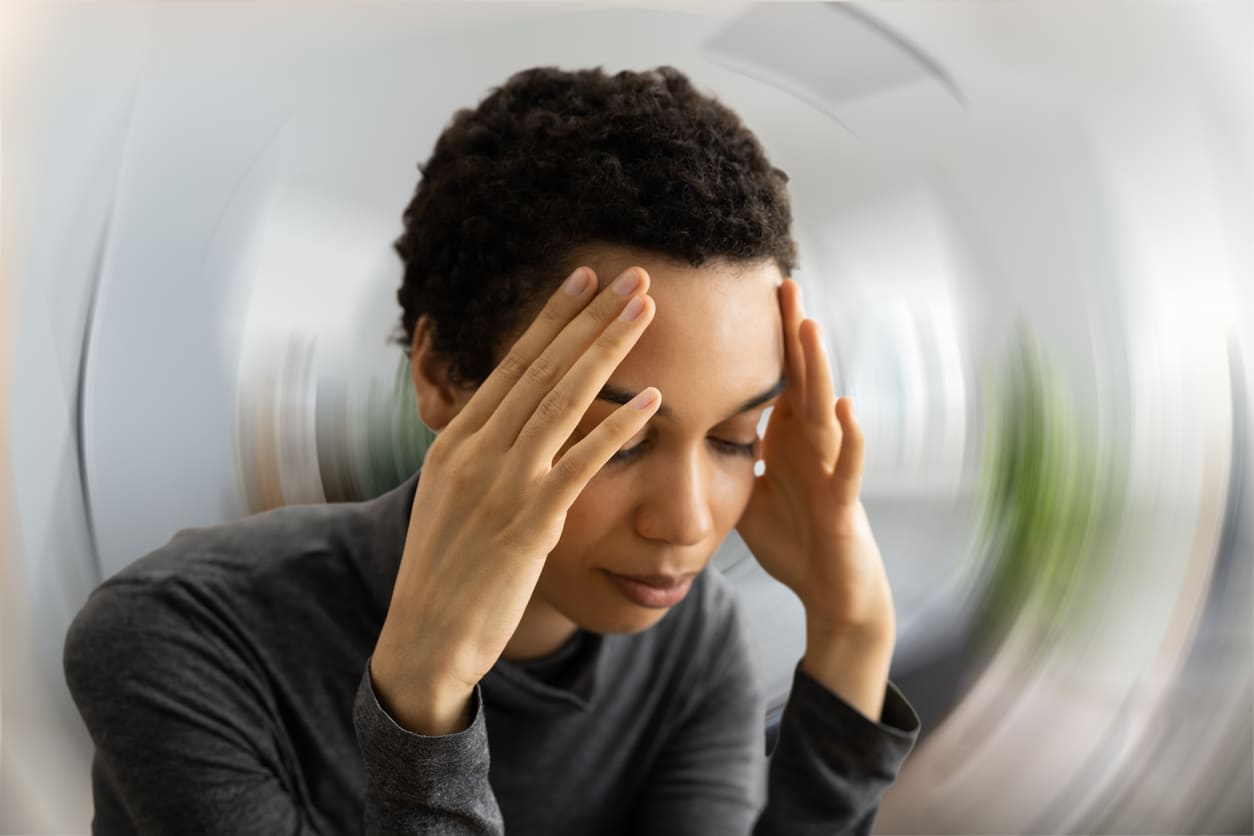How to Stop a Migraine

Migraine headaches can be a quite painful and debilitating condition, but they can be treated.
Migraines are painful, episodic headaches that are triggered by various external or internal factors. Treatments for migraines are designed to both alleviate a migraine already in progress and ways to prevent them from occurring. Some people only have migraines occasionally, but others experience several “migrain days” a month, which has a severe impact on their quality of life. In addition to severe head pain, migraine is often accompanied by nausea, vomiting, and sensitivity to light.
What Are Migraines?
Migraine is a neurologic disorder that causes severe episodic headaches. The pain is described as a throbbing, deep pulsing sensation, usually on one side of the head.
Migraines come in attacks that can last anywhere from a few hours to days at a time. The attacks often come with some kind of warning, a period known as “prodrome.” During prodrome in the days or hours before your attack, you may notice things like an increased sensitivity to light, constipation, mood swings, food cravings, or a need to urinate more often.
“Prodrome” is one of the four stages of migraine, the other three being aura, attack, and post-drome.
Causes and Triggers
Migraines are caused by “triggers.” These triggers impact chemical and neurological pathways in the brain. There are any number of triggers of migraines: stress, strobing or flickering lights, particular foods, and even certain sounds have been known to trigger migraines. Part of your quest to find a way to get rid of migraines for good will involve isolation your specific triggers and learning how to avoid them.
Migraines can occur with or without “auras.” Auras are visual signs that a migraine attack is imminent. Typical migraine auras are blurred vision, eye pain, seeing zig-zag patterns, or what seems like flashing lights.
Temporary Relief vs. Long-Term Solutions
The treatment of migraine involves a three-pronged approach of treating an existing headache, preventive measures, and trigger avoidance. Direct or acute treatment aims to slow or stop the progression of an attack that has already occurred. Preventive treatment is intended to not only reduce the frequency and severity of your attacks but also make direct treatment more effective when and if attacks occur. Getting to know your triggers can help minimize migraine attacks and further improve your quality of life.
The Quest for Permanent Relief
For people who only occasionally experience migraines, over-the-counter headache medications, along with rest in a cool, dark room, are enough for them to recover from their infrequent attacks and go about their lives. However, for others who suffer bouts of painful migraines several times a month, there is a profound need for more permanent relief. That’s where medical interventions and lifestyle changes come into play.
Lifestyle Changes for Migraine Prevention
There is no cure for migraines, but there are lifestyle changes and medical interventions to help prevent them and reduce their severity when they occur. Lifestyle changes to help minimize migraines include stress reduction, getting a good night’s sleep, and eating a healthy diet. Dietary changes would include avoiding any food triggers of your migraines once they have been identified.
There is also a link between hormones and migraines, especially in women. In such individuals, hormone replacement therapies could help to reduce the occurrence of migraines.

Sleep and Migraines
Sleep and migraine headaches are closely linked. Not getting enough sleep can trigger migraines in a number of ways. First of all, sleep has a lot to do with the balance of your hormones and other brain chemicals. Adequate sleep is essential to maintain the proper levels of hormones and neurotransmitters that can keep migraine attacks at bay. In addition, lack of sleep can also increase stress or induce one of your other migraine triggers.
Migraine and sleep deprivation can be a kind of vicious cycle, where not only can disturbed sleep trigger your migraines, but your migraine pain can prevent you from getting enough sleep, creating an ongoing negative feedback loop.
Hormones and Nerve System Connection
There is a sub-type of migraine headaches where hormones are the trigger known as “hormone headaches.” These tend to occur in women who are subject to headaches caused by changes in their hormones during their menstrual cycles and as they enter their menopausal years.
According to the National Migraine Centre, UK, more than half of women who get migraines notice a link with their periods. These so-called “menstrual migraines” tend to be quite painful and debilitating, severely impacting sufferers’ ability to work or engage in other daily activities. These kinds of hormonal migraines in women can also be triggered by the use of certain oral birth-control pills or pregnancy.
Migraine medications, as we will describe in the next section, can be used to help treat hormonal migraines, as could continuous contraceptive pills or hormone replacement therapy (HRT). HRT can be particularly effective in women who are getting migraine headaches in addition to other menopausal symptoms such as hot flashes or night sweats.
In addition to hormones, certain dysfunctions of the nervous system can be a root cause of migraines. The trigeminal nerve is a network of wiring that attaches to special sensors throughout the nerves and muscles of the face, jaw, and teeth. Many migraine sufferers are said to have an over-reactive or hypersensitive trigeminal nerve. All migraine triggers affect the nervous system in one way or another. The trigger somehow either over-stimulates or interferes with the normal electrochemical signals to the brain, resulting in the stages of migraine from the prodrome to the aura to the full-blown attack.

Medical Interventions
In recent years, several effective medical interventions have been developed to treat migraine. These include:
- Antidepressants
- Blood pressure medicines, such as beta blockers
- Anti-seizure medicines
- Calcitonin gene-related peptide (CGRP) agents
Botox has also recently been approved for the treatment of migraine headaches.
Alternative Therapies
There are other medical interventions that are used to prevent or treat migraines, such as single-pulse transcranial magnetic stimulation (sTMS). This type of therapy entails the placement of a device on the back of your head at the start of a migraine. It sends a pulse of magnetic energy to part of your brain, which may stop or reduce pain. Similar devices known as “neuromodulation devices” are also used. These use pulses that affect the vagus nerve and the trigeminal nerve to give relief from or prevent migraines.
Several nutritional supplements such as vitamin D, magnesium, riboflavin, coenzyme Q10, and melatonin have been suggested as possible alternative treatments for migraine, as have “bodywork” such as chiropractic and acupuncture; however, there is only limited evidence to support such claims.
Conclusion
Migraines can be painful and debilitating, but by seeing your doctor for treatment options and making some positive lifestyle changes like getting enough sleep, eating right, and avoiding your triggers, you can find ways to get rid of your migraine for good!

